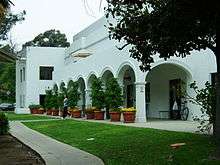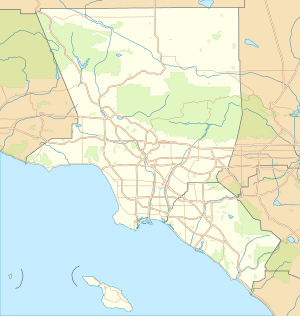Barlow Respiratory Hospital
| Barlow Respiratory Hospital | |
|---|---|
 Barlow Respiratory Hospital | |
 Location in Los Angeles | |
| Geography | |
| Location | 2000 Stadium Way, Los Angeles, California, United States |
| Coordinates | 34°04′34″N 118°14′53″W / 34.076°N 118.248°WCoordinates: 34°04′34″N 118°14′53″W / 34.076°N 118.248°W |
| History | |
| Founded | 1902 |
| Links | |
| Lists | Hospitals in California |
| Official name | Barlow Sanitorium |
| Designated | October 9, 1990[1] |
| Reference no. | 504 |
The Barlow Respiratory Hospital is a hospital located in the Elysian Park neighborhood of Echo Park, near Dodger Stadium in Los Angeles, California.
Originally a tuberculosis sanatorium, Barlow Respiratory Hospital is a long-term acute care facility in Los Angeles that specializes in respiratory diseases and also treats related secondary ailments. The hospital treats approximately 750 patients a year and sets the national benchmark in ventilator weaning at nearly 60%.[2]
The hospital operates satellite sites in Van Nuys, California and in Whittier, California.
Population
The hospital serves an older patient population that suffers from medically complex conditions. Eighty percent of Barlow’s patients are over age 60 and more than half are below the federal poverty level. Eighty percent of its patients are from Los Angeles County while the remaining 20% are admitted from national and international medical facilities. Patients stay at the hospital for an average of 30 days, which is ten times longer than the national average.[3] The patient population is also ethnically diverse and mirrors the diversity of Los Angeles County.
Programs
The hospital has four primary treatment programs. Through these programs, it is able to care for conditions that are often associated with respiratory diseases, thus promoting a holistic model of treatment.
Ventilator Weaning Program
Barlow’s TIPS© Ventilator Weaning Protocol / Ventilator Weaning: Barlow Respiratory Hospital is recognized for a ventilator weaning success rate of nearly 60%, among the highest rate in the nation. Our Barlow TIPS© Ventilator Weaning Protocol was developed by Barlow board-certified pulmonologists based on years of specialized respiratory care practice.
Barlow TIPS© protocol has been adopted as a standard of excellence in hospitals nationwide. Our interdisciplinary Barlow team of health care professional helps patients previously unable to be liberated or "weaned” from the ventilator at other hospitals. Patients are guided through an individualized step-by-step method, implemented and monitored by dedicated respiratory care practitioners, to recover independent breathing. [4]
Wound Care Program
Many patients entering the hospital have been bedridden for long periods of time. Unfortunately, this often requires specialized care in order to treat the resulting bed wounds.[5]
Care for Chronically Critically Ill
For patients whose respiratory illness is complicated by a constellation of complex medical conditions that require intensive treatment and prolonged recovery, Barlow Respiratory Hospital provides a comprehensive multidisciplinary approach. Led by board-certified physicians, our Barlow team provides care for chronically critically ill patients focused on individual needs. On-site physicians and consulting specialists guide the care of patients with: cardiac (heart) diagnoses, neurological conditions, infectious diseases, kidney disease, and blood disorders, as well as those with complex respiratory care needs. Through ongoing assessment and intervention, Barlow's team strives to resolve acute medical conditions, allowing patients to move successfully from the acute care setting to another level of care, or home.[6]
History
Walter Jarvis Barlow founded the Barlow Sanatorium in 1902. He received his MD degree in 1892 from Columbia University. Though he was born and raised in New York, he was forced to move west in search of a dry and sunny climate after contracting tuberculosis in 1895. The sanatorium was founded on 25 acres (10 ha) of meadowland next to the city-owned Elysian Park on Chavez Ravine Road. The location seemed ideal because the surrounding configuration of hills provided for clean air and the neighboring Elysian Park seemed to insure against any future development. The land was purchased for $7,300. Patients were housed in tent cottages that were specifically constructed so that patients would have maximum exposure to fresh air and sunlight; at that time these elements were of primary importance in order to recover from tuberculosis.[7] In the early days of the Barlow Sanatorium patients lived by strict rules; one document read:
" Patients must not expectorate anywhere except in cups provided for that purpose. Cloths are to be used as handkerchiefs and burned morning and evening. Patients must not discuss their ailments or make unnecessary noise. Patients must not put anything hot on glass tables. Lights out at 9 p.m. Cold plunge every morning; hot baths Tuesday and Saturday. Patients are forbidden to throw water or refuse of any kind on the ground. When doctors think them able, every patient must do some work about the Sanatorium or go away. Patients disobeying these rules will be dismissed. "[8]
As the century continued, medical advances made tuberculosis a less serious threat in the United States. Because of this, the tuberculosis sanatorium shifted its focus towards chronic respiratory diseases and secondary related diseases.[9]
The site was named a Los Angeles Historic-Cultural Monument in 1990.[1]
Timeline
- 1902 - Founder Walter Jarvis Barlow, M.D., attempting to recover from tuberculosis himself moved west in search of a milder climate. During this year he established Barlow Sanatorium to care for others with tuberculosis.
- 1925 - The Solano Infirmary, the original hospital structure, burned down, but quick action by the fire department prevented any loss of life. By 1927, the infirmary reopened.
- 1937 - Dr. Walter Jarvis Barlow, founder of the Barlow Sanatorium, died at the age of 69.[10]
- 1938 - An official affiliation was forged with the University of Southern California Medical School that continues today.[11][12]
- 1944 - Effective treatment for tuberculosis was first developed, which brought much promise for those suffering with this disease.[13]
- 1960s - Barlow Sanatorium transforms into a hospital for chronic respiratory diseases.
- 1970 - Barlow begins to admit patients for weaning from prolonged mechanical ventilation.
- 1990 - Barlow Respiratory Research Center was established.[14]
- 1994 - The Barlow Foundation was incorporated.[15]
- 1997 - The first satellite facility opened at Presbyterian Intercommunity Hospital in Whittier.[2]
- 2007 - The second satellite facility opened at Valley Presbyterian Hospital in Van Nuys.[2]
- 2015 - New CEO, Amit Mohan, PhD, FACHE, FACMPE, joins the Barlow Respiratory Hospital team.
Buildings on the campus


Barlow Respiratory Hospital is unique in that it maintains a 25-acre campus with cottages, a library, the main hospital, and a community hall. Old chicken coops are still standing on the outskirts of the campus. This unique layout can be attributed to the hospital's history as a tuberculosis sanatorium where patients lived for several years.
Cottages on the campus
Originally tuberculosis patients lived in tent cottages in order to be constantly exposed to free flowing air. As time went on permanent cottages were added to the campus by various donors. The style of these cottages reflected the popular trends of Los Angeles of the time. The architecture of the bungalows is in the California bungalow style.[16] During World War I many servicemen contracted tuberculosis and were sent to the Barlow Sanatorium. Because of this the Los Angeles Chapter of the American Red Cross built and furnished four four-room cottages for military patients, some of which are still in use today.
The library
Dedicated to the sanatorium on May 6, 1922, this stucco and red tiled library is still in use today. It was paid for by the Los Angeles Optimists Club and has stained glass windows donated by James Slauson and a second by Mrs. Helena Torrance in memory of her husband, Jared Sidney Torrance. Jared Sidney Torrance had served on Barlow’s Board of Trustees since 1910 as vice president and president. The library underwent renovations in 1992.[17]
The Guildhouse
The Guildhouse was originally the "Men’s Help" quarters, where the men working in the hospital would live. In 1975 the old building was converted into a gift and plant shop. This was funded by the Barlow Guild, a large group of ex-patients dedicated to philanthropy, and the Guildhouse opened in April of that year.[18]
The hospital
In 1903, the original hospital of the Barlow Sanatorium was a permanent cottage with 13 rooms, two baths and 12 patient beds. It was built with donations from Mr. and Mrs. Alfred Solano, and was consequently named the Solano Infirmary.[19] In September 1925, the Solano Infirmary burned down. Thankfully, no one died. In 1927 Alfred's wife, Mrs. Ella Brooks Solano, provided for the creation of a new infirmary, the Ella Brooks Solano Infirmary, a building that is still in use as the main hospital today.
Notes
- 1 2 Department of City Planning. "Designated Historic-Cultural Monuments". City of Los Angeles. Retrieved 2012-10-04.
- 1 2 3 http://www.barlow2000.org/main.php?pri=6&sec=2&ter=2
- ↑ http://www.latimes.com/news/local/la-me-outthere26-2008dec26,0,2812295.story
- ↑ "Archived copy". Archived from the original on 2011-07-25. Retrieved 2009-07-06.
- ↑ "Archived copy". Archived from the original on 2009-12-14. Retrieved 2009-07-06.
- ↑ "Archived copy". Archived from the original on 2011-07-25. Retrieved 2009-07-06.
- ↑ Finegan, 1992.
- ↑ Finegan 1992, p. 11.
- ↑ http://www.barlow2000.org/main.php?pri=1&sec=8&ter=2
- ↑ http://select.nytimes.com/gst/abstract.html?res=F10C17F63C591B7489DDAC0894D1405B878FF1D3
- ↑ http://www.usc.edu/schools/medicine/patient_care/hospitals_clinics/satellite_locations.html
- ↑ Finegan 1992, p. 53.
- ↑ http://nobelprize.org/educational_games/medicine/tuberculosis/readmore.html
- ↑ "Archived copy". Archived from the original on 2008-12-23. Retrieved 2009-07-06.
- ↑ http://www.barlow2000.org/main.php?pri=6&sec=7&ter=1
- ↑ "Archived copy" (PDF). Archived from the original (PDF) on 2008-10-07. Retrieved 2009-07-08.
- ↑ Finegan 1992, p. 53.
- ↑ Finegan 1992, p. 57.
- ↑ Finegan 1992, p. 7.
References
- Finegan, Robert. The Barlow Story An Illustrated History of Barlow Respiratory Hospital 1902-1992. 1992. Crown Printers, San Bernardino, California.
Further reading
- Abel, Emily K. Tuberculosis and the Politics of Exclusion: A History of Public Health and Migration to Los Angeles. New Brunswick: Rutgers University Press, 2007, ISBN 978-0813541761
- Abel, Emily K. Suffering in the Land of Sunshine: A Los Angeles Illness Narrative. New Brunswick: Rutgers University Press, 2006, ISBN 978-0813539010
External links
| Wikimedia Commons has media related to Barlow Respiratory Hospital. |
- Official website
- Oshpd.ca.gov: Barlow Respiratory Hospital in the California Healthcare Atlas — a project by OSHPD.